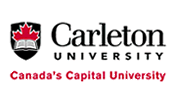 |
|
||||
Org: David Kribs (Guelph)
[PDF]
- THOMAS DECKER, McGill University, School of Computer Science, 3480 University Street, Montreal, Quebec, H3A 2A7
Symmetric measurements attaining the accessible information [PDF] -
A theorem of Davies states that for symmetric quantum states there exists a symmetric POVM maximizing the mutual information. To apply this theorem the representation of the symmetry group has to be irreducible. We obtain a similar yet weaker result for reducible representations.
- GUS GUTOSKI, University of Waterloo
Properties of Local Quantum Operations with Shared Entanglement [PDF] -
Multi-party local quantum operations with shared quantum entanglement or shared classical randomness are studied. The following facts are established:
- There is a ball of local operations with shared randomness lying within the space spanned by the no-signalling operations and centred at the completely noisy channel.
- The existence of the ball of local operations with shared randomness is employed to prove that the weak membership problem for local operations with shared entanglement is NP-hard.
- Local operations with shared entanglement are characterized in terms of linear functionals that are "completely" positive on a certain cone K of separable Hermitian operators, under a natural notion of complete positivity appropriate to that cone. Local operations with shared randomness (but not entanglement) are also characterized in terms of linear functionals that are merely positive on that same cone K.
- Existing characterizations of no-signalling operations are generalized to the multi-party setting and recast in terms of the Choi-Jamiolkowski representation for quantum super-operators. The relationship between no-signalling operations, local operations with shared entanglement, and so-called "separable" quantum operations is briefly discussed.
- There is a ball of local operations with shared randomness lying within the space spanned by the no-signalling operations and centred at the completely noisy channel.
- NATHANIEL JOHNSTON, University of Guelph, 50 Stone Road East, Guelph, Ontario, N1G 2W1
The Multiplicative Domain in Quantum Error Correction [PDF] -
Quantum error correction deals with correcting errors introduced via quantum channels, modelled by trace-preserving completely positive maps. Correctable subsystems are roughly subsystems of the overlying Hilbert space on which the channel has a left inverse. Given a unital completely positive map, the multiplicative domain of that map is the largest subalgebra on which the map acts as a homomorphism. We show that for a unital quantum channel, the correctable subsystems that are correctable via conjugation by a unitary (called unitarily correctable subsystems) are exactly what are captured by that map's multiplicative domain. We also show that if we remove the requirement that the map be unital, a weaker relationship between the two notions still holds.
This is joint work with Man-Duen Choi and David Kribs.
- DAVID POULIN, Sherbrooke
-
- MARY BETH RUSKAI, Tufts University
Additivity after Hastings [PDF] -
Hastings has recently shown that the conjectured additivity of minimal output entropy is false. Put in a more positive light, this implies that entangled inputs can enhance the capacity of memoryless quantum channels for transmitting classical information. We consider the new issues and challenges that emerge from this breakthrough.
- GRAEME SMITH, IBM Watson
-
- JON YARD, Los Alamos National Laboratory
Quantum communication with zero-capacity channels [PDF] -
A quantum channel models a physical process in which noise is added to a quantum system via interaction with its environment. Protecting quantum systems from such noise can be viewed as an extension of the classical communication problem introduced by Shannon sixty years ago. A fundamental quantity of interest is the quantum capacity of a given channel, which measures the amount of quantum information which can be protected, in the limit of many transmissions over the channel. In this talk, I will show that certain pairs of channels, each with a capacity of zero, can have a strictly positive capacity when used together, implying that the quantum capacity does not completely characterize a channel's ability to transmit quantum information.
This is joint work with Graeme Smith (IBM) published in Science on Sept. 26, 2008.





